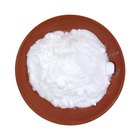
If you have tomato juice in your pantry, you also have the foundation for a variety of sauces including pizza sauce. The basic flavor profile of this juice adapts well to pizza as long as you add traditional flavorings like Italian seasoning, tomatoes, garlic, a pinch of sugar and Parmesan cheese. While tomato juice alone also isn't thick enough for a proper pizza sauce, thickening it is relatively simple -- and you likely already have some thickening options in your kitchen as well.
Roux
You can thicken your tomato juice with a roux, which is just a blend of fat and flour in a 1-to-1 ratio. About two tablespoons of roux will thicken a cup of liquid. For the fat, you can use oil or butter, depending on your taste preference. Olive oil works well for a pizza sauce. To make the roux, warm the oil until it's hot in a pan. Then add your flour, stirring constantly. You want to cook the flour and oil until it begins to color and the raw flavor of the flour cooks out. Don't cook it over high heat, as your roux might burn. When the mixture turns into a bubbling paste, add your spices and slowly whisk in the tomato juice. Continue stirring until the pizza sauce reaches the desired consistency.
Tomato Products
Tomato paste is a thickening agent that is somewhat bitter. If you use it to thicken your tomato juice, heat the tomato juice and paste in your saucepan until you're happy with the texture. Add spices to your personal taste, and use a little extra sugar to offset the paste's acidity. You can also add crushed and/or stewed tomatoes for more flavor and a chunkier consistency. Just drain off the excess liquid from the crushed or stewed tomatoes before adding them to your sauce. If you want to add the tomatoes for flavor, but want a smooth sauce, put the sauce through a sieve after cooking.
Reduction
A reduction is a simple way to thicken any sauce. This method cooks off the amount of water in the juice by applying heat. Start by putting the juice in a sauce pan and bring it to a rolling boil. Turn down the heat and let the sauce simmer. As it simmers, you’ll notice the amount of liquid decreasing. Stir periodically and continue simmering until you’re happy with the consistency. It takes at least one hour for 12 ounces of juice to begin thickening. At this juncture, add spices to your personal taste. Continue cooking to the desired thickness. This should make enough sauce for a large pizza, depending on how heavily you apply it. Alternatively, you can microwave your juice on high using a microwave-safe container. Reducing this way takes between 20 and 30 minutes to obtain 1 cup of sauce.
Thickening agents
Flour, cornstarch and arrowroot are three potential thickening agents for your tomato juice. All three of these work best as a slurry, which you make by blending equal amounts of the thickening agent with cold water. Once mixed, slowly stir your slurry into your boiling, already seasoned, tomato juice. Be conservative when it comes to the amount of slurry you add. You can always add more if desired. Keep in mind that cornstarch will typically work better than flour, which may separate or lump. Arrowroot is more expensive than cornstarch.
Related Articles

How to Make Hot Dog Chili (Coney Island ...

How to Get Rid of the Acid Taste in ...

How to Make French Sauce With Roux of ...

How to Store Henna Paste

How to Make Canned Gravy Taste Better

How to Make Chocolate Juice

How to Cook Down Apple Juice to Make ...

How to Tone Down Spiciness in BBQ Sauce

How to Make A1 Steak Sauce Thick & ...

How to Make Fish Taco Sauce

How to Substitute Cornstarch for ...

Can You Use Matzo Flour to Thicken ...

How to Use Pectin to Thicken Sauces

How to Cook Venison With Tomatoes in a ...

How to Fix Watery Henna

How Long Can You Refrigerate Nacho ...

What Is Ratio for Cornstarch & Water to ...

What Can I Substitute for Cornstarch?

How to Thicken Chili with Cornmeal

How to Make Prime Rib Pan Gravy
References
Resources
Writer Bio
Patricia Telesco has been a writer since 1992. She has produced more than 60 books with publishers that include HarperCollins and Simon & Schuster. Her articles have appeared in "Woman's World" and "National Geographic Today." Telesco holds a Bachelor of Arts in English from the University of Buffalo.
Photo Credits
Jupiterimages/Photos.com/Getty Images